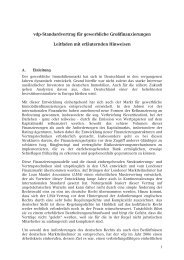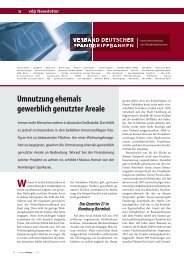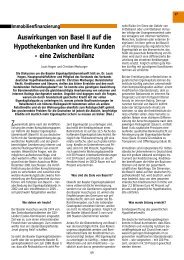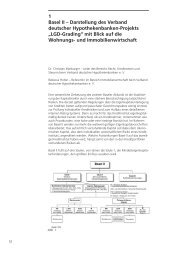The Pfandbrief 2011 | 2012
The Pfandbrief 2011 | 2012
The Pfandbrief 2011 | 2012
You also want an ePaper? Increase the reach of your titles
YUMPU automatically turns print PDFs into web optimized ePapers that Google loves.
Roundtable <strong>Pfandbrief</strong> Banks<br />
2.<br />
<strong>The</strong> volume of <strong>Pfandbrief</strong>e has been on the decline for years. How long will this<br />
development continue? What impact will it have on investor behavior?<br />
Tanja Stephan (TS): It is true that the volume of <strong>Pfandbrief</strong>e has fallen continuously since the<br />
year 2000. As a matter of fact, however, this consolidation has taken place only in the case of<br />
the Public <strong>Pfandbrief</strong>. Mortgage <strong>Pfandbrief</strong>e present a different picture: their volume has consistently<br />
been in excess of €220 billion since 1998. Before the financial market crisis, Public<br />
<strong>Pfandbrief</strong>e were long considered by investors to be a surrogate for government bonds and<br />
were marketed as such. All this has changed. Investors are placing greater emphasis on the<br />
quality and diversification of the cover pools and a balanced management of the cover assets.<br />
Parallel to this development, a number of issuers have made portfolio restructurings and<br />
reductions; this, overall, will lead to a further decrease in public sector cover pools and, consequently,<br />
in Public <strong>Pfandbrief</strong> issues.<br />
HB: Given the large volume of maturities in formerly government-guaranteed loans to savings<br />
banks and Landesbanken in the coming years, the total volume of <strong>Pfandbrief</strong>e outstanding is<br />
likely to decline further until the end of 2015.<br />
58<br />
3.<br />
<strong>The</strong> sovereign debt crisis has brought Public <strong>Pfandbrief</strong> issuers back into investors’<br />
field of vision. A particularly critical view is held of exposure to peripheral states.<br />
Are foreign cover assets going to disappear from Public <strong>Pfandbrief</strong> cover pools?<br />
RG: First of all, it needs to be said that investments were made in bonds of the countries<br />
affected – all of which are members of the Eurozone – for reasons of portfolio diversification.<br />
<strong>The</strong> volumes are correspondingly small in terms of total holdings. <strong>The</strong> extent to which foreign<br />
cover assets will disappear from public sector cover pools depends on the orientation of each<br />
<strong>Pfandbrief</strong> bank’s business model.<br />
TS: Every cover pool is a portfolio which has to be actively managed, in particular, from the<br />
point of view of risk, return and liquidity. This makes diversification of credit qualities and<br />
asset classes indispensible. I don’t think there is anything to be gained by restricting by region<br />
the assets that are to qualify as cover; the opposite is probably the case.<br />
4.<br />
Some <strong>Pfandbrief</strong> issuers are doing away with small-scale property finance. At the<br />
same time, commercial mortgages are subject to greater price fluctuations. What are<br />
the implications for the cover pools?<br />
RG: That statement is true of some, but not all, <strong>Pfandbrief</strong> issuers. Some have always considered<br />
private residential property finance as their core business. Particularly in the financial<br />
market crisis, this core business and the granular portfolio it entails has proven to be very<br />
sound and sustainable.
















